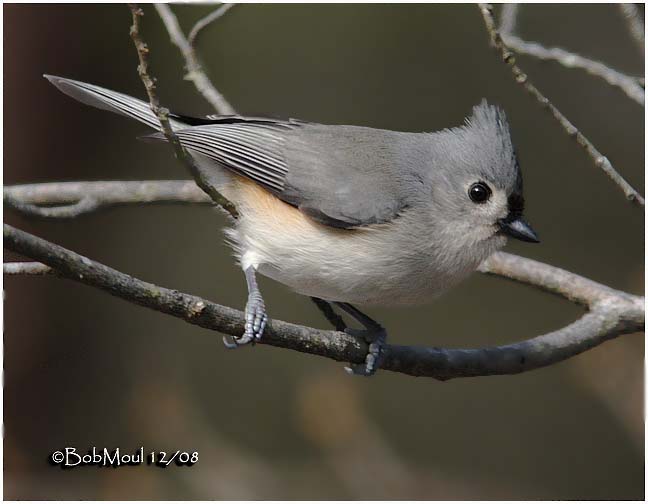
Tufted Titmouse
Baeolophus bicolor
Passeriforme Order – Paridae Family
BIOMETRICS:
Length: 14-16 cm
Wingspan: 20-26 cm
Weight: 18-26 g
LONGEVITY: up to 13 years.
DESCRIPTION:
Tufted Titmouse has grey erected crest and black forehead. But in south and west Texas, birds ( Black-crested Titmouse - Baeolophus atricristatus) have whitish forehead and blackish crest, (Black-crested Titmouse), and they are two separated species.

Tufted Titmouse has grey upperparts, and darker flight feathers. Face and underparts are white, and it has rusty flanks.
Eyes are black, with dark eye ring, giving an impression of large size. Bill is black, short and powerful. Legs are blue-grey. Lores are pale buff.
Both sexes are similar.
Juvenile resembles adults with paler forehead, upperparts tinged with brownish and greyer chest.
VOICE: SOUNDS BY XENO-CANTO
Tufted Titmouse’s typical song is a loud whistled “peta-peta-peta”. It often gives a high-pitched alarm call, if a hawk is flying overhead and a hiss if its eggs are threatened. We can also hear a variety of whispers and warbles.
It is a noisy bird.
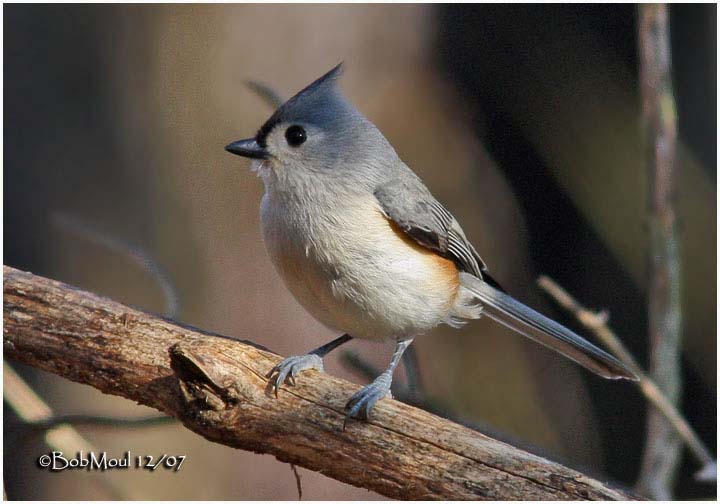
HABITAT:
Tufted Titmouse is common in deciduous woodlands, parks and urban areas where it frequents feeders. It needs habitat with varied large trees, with a dense canopy, and it nests in or near swamps, orchards and suburbs.
RANGE:
Tufted Titmouse inhabits all year round in the eastern half of United States.
BEHAVIOUR:
Tufted Titmouse is a noisy bird, very active. It is dominant at feeders, chasing away other small birds.
To feed, Tufted Titmouse gleans preys from tree bark, twigs, but also on the ground. It stores seeds and acorns throughout its territory during winter, in bark crevices, but it doesn’t remember where. It often forages in mixed flocks.
It hangs upside down searching insects. It may take food from human hand, coming at the sound of voices.
She feeds at all tree’s levels, from the ground to the canopy, according to the season.
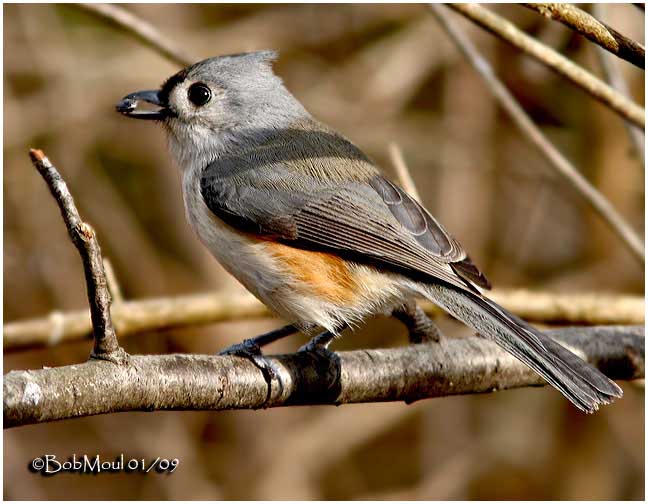
Tufted Titmouse defends its territory all year round. Male and female stay together until the death of one of the mates. Male performs courtship feeding during breeding season.
Sometimes, parents have helpers to care the chicks. The young of the first clutch may help their parents to raise the second brood.
Tufted Titmouse lines its nest with hair or fur from squirrel’s tail, or other animals, and even from human’s head.
FLIGHT:
Tufted Titmouse may hover momentarily while it forages among branches.
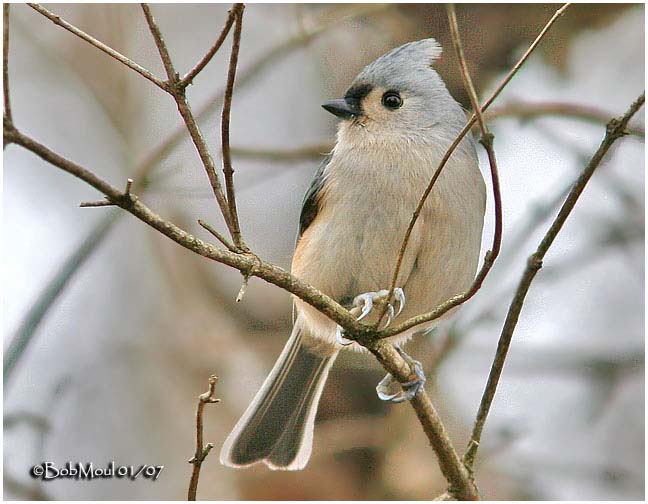
REPRODUCTION:
Breeding season occurs from late March to mid-June.
Tufted Titmouse prefers to nest fairly high in trees, at up to 90 feet above the ground. It is a cavity nester, but it doesn’t excavate the hole. It nests in old woodpecker holes, or broken limbs, and only for one season.
Nest is a cup made with leaves, moss, dried grasses and bark strips. It is lined with feathers, fur, wool, cotton, hair from living mammals, and sometimes snake-skin.
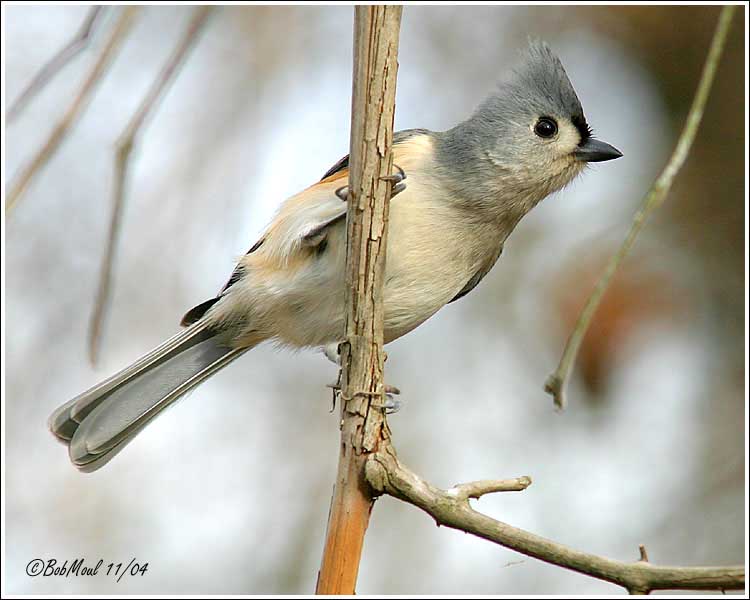
Female lays 5 to 6 eggs, one egg per day. Eggs are smooth and non glossy, whitish, speckled and spotted with varied colours.
Incubation lasts about 12 to 14 days, by female. Male feeds female until the eggs hatch. If female leaves the nest, she covers the eggs with nesting materials.
Chicks hatch altricial, and female broods them for a few days. Male continues to feed her and the young. When chicks become older, female helps the male to feed them, sometimes helped by the chicks from the first clutch.
Young fledge at 15 to 16 days of age. They feed themselves 5 days later, but they remain with parents several weeks more before to be independent.
This species produces two clutches per year in the southern part of its range, and one single clutch in northern part.
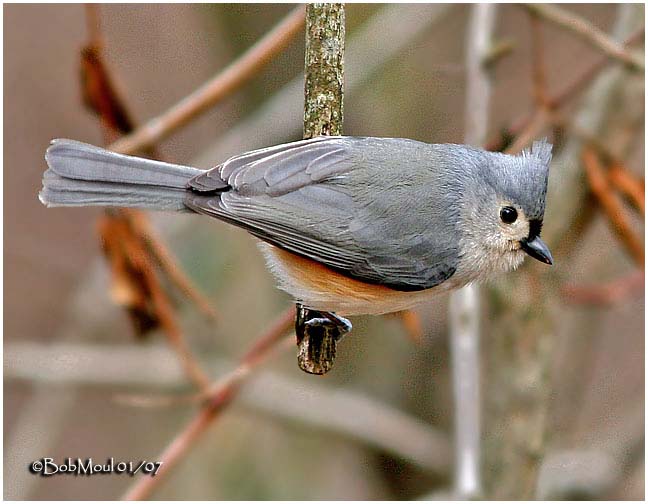
DIET:
Tufted Titmouse feeds on invertebrates, insects (caterpillars, beetles, wasps, ants, and bees), spiders and snails.
In winter, they also eat berries, fruits, acorns, nuts and seeds, and suet and bread from feeders.
Tufted Titmouse eats regularly snow when water is not available.
PROTECTION / THREATS / STATUS:
Tufted Titmouse has predators, such as hawks, owls, snakes and cats. Populations of this species are widespread and abundant, and continue to expand their range to the north.
Fr: Mésange bicolore
All : Indianermeise
Esp : Herrerillo Bicolor
Ital : Cincia bicolore americana
Sd : östlig grames
Photographs by Bob Moul
His website :
Nature Photography
Text by Nicole Bouglouan
Sources:
HANDBOOK OF THE BIRDS OF THE WORLD Vol 12 by Josep del Hoyo-Andrew Elliott-David Christie - Lynx Edicions - ISBN: 8496553423
FIELD GUIDE TO THE BIRDS OF NORTH AMERICA by National Geographic Society - National Geographic Society - ISBN: 0792274512
All About Birds (Cornell Lab of Ornithology)
What Bird-The ultimate Bird Guide (Mitchell Waite)
Wikipedia (Wikipedia, The Free Encyclopedia)
Animal Diversity Web (University of Michigan Museum of Zoology)